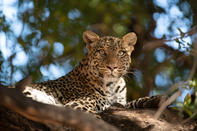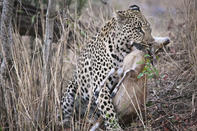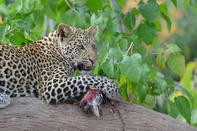The name of the leopard (Panthera Pardus) derives from Greek words that means lion and panther, because of an earlier belief that leopards were a hybrid between a lion and panther. The leopard is described as one of the most elusive of large carnivores.

The African leopard varies in size and colour depending on its location and habitat. Leopard colour ranges from pale yellow to deep gold or tawny, with black and strawberry variations caused by autosomal recessive genes.
Cape leopards from the coastal mountain areas of the Western Cape are significantly smaller than the leopards found in the rest of the country, with males weighing around 31 kg and the females around 21 kg. Males in the Kruger National Park, in contrast, may weigh around 58 kg, while the females weigh about 37,5 kg.
In spite of this, the home range of the Cape leopard is larger because of the lower availability of food, ranging between 200 km² and 1 000 km², in comparison with that of the ones in the Kruger National Park, which ranges between 25 km² to 50 km². Where cheetahs have individual spots, leopards have rings of spots known as rosettes on their bodies and solid black spots on their legs, head, sides and hindquarters.
They are more heavily spotted and do not have the black facial lines of a cheetah. They generally prefer koppies and riparian woodlands and avoid grassland. Koppies are often selected as den sites for young cubs and vantage points from which to locate prey. While leopards become sexually mature from around 24 months, they usually only breed from three years old.
Two to three cubs are born per litter, after a gestation period of roughly 100 days. Cubs are born and hidden away in thick vegetation. They are extremely vulnerable during the first year of their lives, especially if they are living in an area where food is scarce.
Cub mortalities range between 35% and 90% depending on the habitat. Females raise their cubs without any help. The cubs normally leave their mother when they are around 15 months old.
Killing and Feeding Pattern

Leopards are primarily night creatures but may be active in the early morning hours when undisturbed. Their diet ranges from small insects to mammals and other carnivores, but they generally prefer prey that weighs 10 kg to 40 kg. Caracal and jackal numbers usually go down in areas where they have to compete with a leopard for food.
Studies by the Predation Management Forum show that leopards usually only prey on livestock in areas where alternatives are scarce. They are known to kill more than they need, but only feed on one carcass at a time. They are heavier and stronger than cheetahs, so do not chase their prey but stalk and pounce on it.
The prey is suffocated with a bite to the neck or throat and then dragged away where it can be eaten in safety, for example, under a dense bush, among rocks or high up a tree. Drag marks to where the prey has been taken will, therefore, be visible. Claw marks may also be seen on the rump or shoulders of larger domestic stock, whereas the neck of smaller prey may be broken.
According to the Predation Management Manual, a great deal of hair is plucked, with the leopard usually eating from the inside of the hind legs and consuming 1 kg to 2 kg of the meat. They seldom remove the intestines.
Management

Leopards are a protected species and in the Western Cape, only conservation officials are allowed to set cage traps. In other provinces, farmers may apply for a permit to set cage traps and should contact their nature conservation authorities to relocate the leopards, once caught.
Anatolian sheepdogs and donkeys have been effective in helping to prevent leopard predation, but the dogs and donkeys need to be raised with livestock to be effective protectors. Fencing and the kraaling of livestock will also help.
By Glenneis Kriel